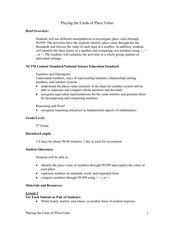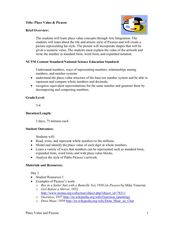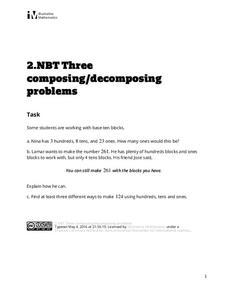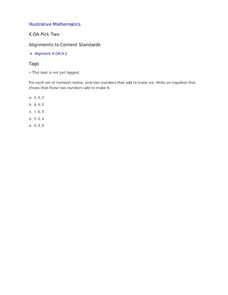Curated OER
Playing the Cards of Place Value
Third graders explore place value to the ten-thousands place. In this amazing, 21-page place value instructional activity, learners represent numbers in standard and expanded form, and use technology to represent numbers to 9,999.
Curated OER
Place Value & Picasso
Place value to the millions is the focus of this math lesson. Third and fourth graders investigate multiple ways to represent a number. They examine place value while studying factual information about Pablo Picasso. Resources are provided.
K20 LEARN
Building Numbers: Addition And Subtraction Up To 10
Animals on Board! Stuart J. Murphy introduces scholars to composed numbers in preparation for writing and drawing true or false number sentences. A game of Bear in the Cave challenges pupils to locate a missing addend. Sorting number...
K20 LEARN
Building To 100: Building And Decomposing Numbers
Following a catchy video about decomposing numbers, young mathematicians build and write numbers using dice. Class members work to create an anchor chart that displays six ways to make numbers. Beans get scooped and estimated, then...
K20 LEARN
Decomposers—Fraction Style: Fractions
"What are fractions composed of?" is the essential question of a lesson designed to enhance understanding and strengthen the foundation of adding fractions. Mathematicians start by discussing what makes an equation true or false, then...
Arcademics
Hungry Puppies
It all comes down to the treats. Individuals compete to find decimals' addends to arrive at a given sum. Pupils click on two dog treats with values that add to the target number. Each round contains the same sum and lasts a minute, and...
Illustrative Mathematics
Making 22 Seventeenths in Different Ways
There is more than one way to determine a sum. Scholars demonstrate their understanding of the decomposition of fractions similar to the decomposition of whole numbers. The short task requires pupils to determine which sums of fractions...
Illustrative Mathematics
Hitting the Target Number
Make combinations to reach the target. Learners play a game to add and subtract numbers between 0 and 10 to reach a target number between 10 through 20. Teachers use the game to help pupils learn efficient ways to add and subtract within...
Illustrative Mathematics
Three Composing/Decomposing Problems
Practice composing and decomposing numbers in base-ten using three word problems. Each problem presents a different scenario requiring learners to explain their thinking, find the number of ones, and find out different ways to make a...
Illustrative Mathematics
Boys and Girls, Variation 2
How many ways can you make the number 9? Use a task that has pupils thinking about the many different ways a classroom of nine can be made up of boys and girls.
Illustrative Mathematics
Making 124
How many ways can you make the number 124 using only tens and ones? Use a task that prompts young mathematicians to make 124 in as many ways as possible.
West Contra Costa Unified School District
Simplifying Fractions Activity
Warm-up pupils' fraction muscles with a four-question quiz, then delve into a learning game designed to reinforce the concept of simplifying fractions. Based on the "I do, We do, You do" method of teaching, the instructional...
Noyce Foundation
Apple Farm Field Trip
Monitor the growth of young mathematicians with a comprehensive addition and subtraction assessment. Using the context of a class field trip to an apple orchard, this series of four story problems allows children to demonstrate their...
Illustrative Mathematics
Christina's Candies
Help Christina figure out how many chocolate and lemon candies she has with a lesson on decomposing numbers. When presenting this context to the class, the teacher chooses the total number of candies and the number that are chocolate,...
Illustrative Mathematics
Pick Two
Learning to break apart numbers into smaller pairs is a critical step young mathematicians take as they develop their number sense. To practice this skill, children are provided with sets of three numbers and are asked to pick the two...
Illustrative Mathematics
What’s Missing?
Now you see them, now you don't! This fun peek-a-boo activity engages young mathematicians in developing their ability to compose and decompose numbers. After being presented with a series of counters, children close their eyes while the...
Illustrative Mathematics
Shake and Spill
Entertaining as well as educational, this math activity about decomposing numbers is bound to capture the engagement of young learners. Given a cup and five two-color counters, young mathematicians simply shake and spill the cup,...
Curated OER
Math Circus: Tens and Ones
Join the math circus! This themed place value activity begins with visual examples for learners to understand number composition with regard to tens and ones. They try a few on their own using the visual clues then complete 14 on their...
Curated OER
Ones and Tens Place Fill Ins Worksheets
There are five numbers here, each of which needs to be decomposed into place values. Young mathematicians complete missing information in a chart which splits numbers into tens and ones. They must fill in the numerals or the tallies...
Curated OER
Partitioning Numbers
Partitioning or decomposing double and triple-digit numbers is a wonderful way to build number sense and a basic understanding of place value. Here are 12 different numbers, partitioned into their base units and tens or hundreds...
Curated OER
Tens and Ones Guided Lesson
Understanding place value will open up a world of math comprehension for your learners. There are three parts to this worksheet, all with the objective of revealing the decomposition of numbers into tens and ones. First, scholars examine...
Curated OER
Problem Solving
Give kids a few strategies to help them become amazing problem solvers. This presentation is intended to be used over a two-day period and presents several techniques or ways to solve word problems or multiplication problems by...
Curated OER
Addition and Subtraction up to 100
After reviewing double-digit addition and subtraction up to and from 100, learners are introduced to addition and subtraction up to and from 10,000. A grid is used along side number decomposition to help them solve a word problem...
Curated OER
Horizontal Addition
Here are four examples of double-digit horizontal addition. Learners are shown how to compute numbers horizontally, by first adding the tens and then the ones columns and then adding them both together. This is a great way to boost...

























